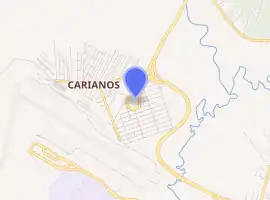Estádio da Ressacada
The Estádio Aderbal Ramos da Silva, usually called Estádio da Ressacada or just Ressacada, is a football stadium inaugurated on November 15, 1983 in Carianos neighborhood, Florianópolis, Santa Catarina, with a maximum capacity of approximately 19,000 people. The stadium is owned by Avaí. Its formal name honors Aderbal Ramos da Silva, who was president of the Santa Catarina Football Federation and was also governor of the state.
"Ressacada" "Ressacada's Monumental" "Blue Temple" | |
 | |

| |
| Full name | Aderbal Ramos da Silva Stadium |
|---|---|
| Location | Florianópolis, Brazil |
| Coordinates | 27°39′59″S 48°31′54″W |
| Owner | Avaí |
| Capacity | 17,800[1] |
| Record attendance | 25,735 |
| Field size | 110 x 75 m |
| Surface | Grass |
| Construction | |
| Broke ground | 1983 |
| Built | 1983 |
| Opened | November 15, 1983 |
| Renovated | 2006 |
| Architect | Davi Ferreira Lima |
| Tenants | |
| Avaí | |
Several matches of the Brazilian football team, as well as the Brazilian football Olympic team were played at Ressacada stadium.
This stadium should not be confused with Blumenau's stadium, which is also called Estádio Aderbal Ramos da Silva, however it is nicknamed DEBA, and has a maximum capacity of 4,000 people.
History
In 1982, to replace the old Estádio Adolfo Konder, Avaí bought a groundplot close to the city's airport (Hercílio Luz International Airport). The construction works were led by Cairo Bueno, and the stadium was designed by the architect Davi Ferreira Lima.
The inaugural match was played on November 15, 1983, when Vasco da Gama beat Avaí 6-1. The first goal of the stadium was scored by Vasco da Gama's Wilson Tadei.
On May 31, 1986, the stadium lights were inaugurated.
The stadium's attendance record currently stands at 25,735, set on July 17, 1988 when Avaí beat Blumenau 2-1, for the Campeonato Catarinense final.
Events
The Ex-Beatle Paul McCartney played a concert at the stadium on April 25, 2012 in front of 30.000 fans during his On the Run Tour, this one been his first concert in the city.
References
- Enciclopédia do Futebol Brasileiro, Volume 2 - Lance, Rio de Janeiro: Aretê Editorial S/A, 2001.